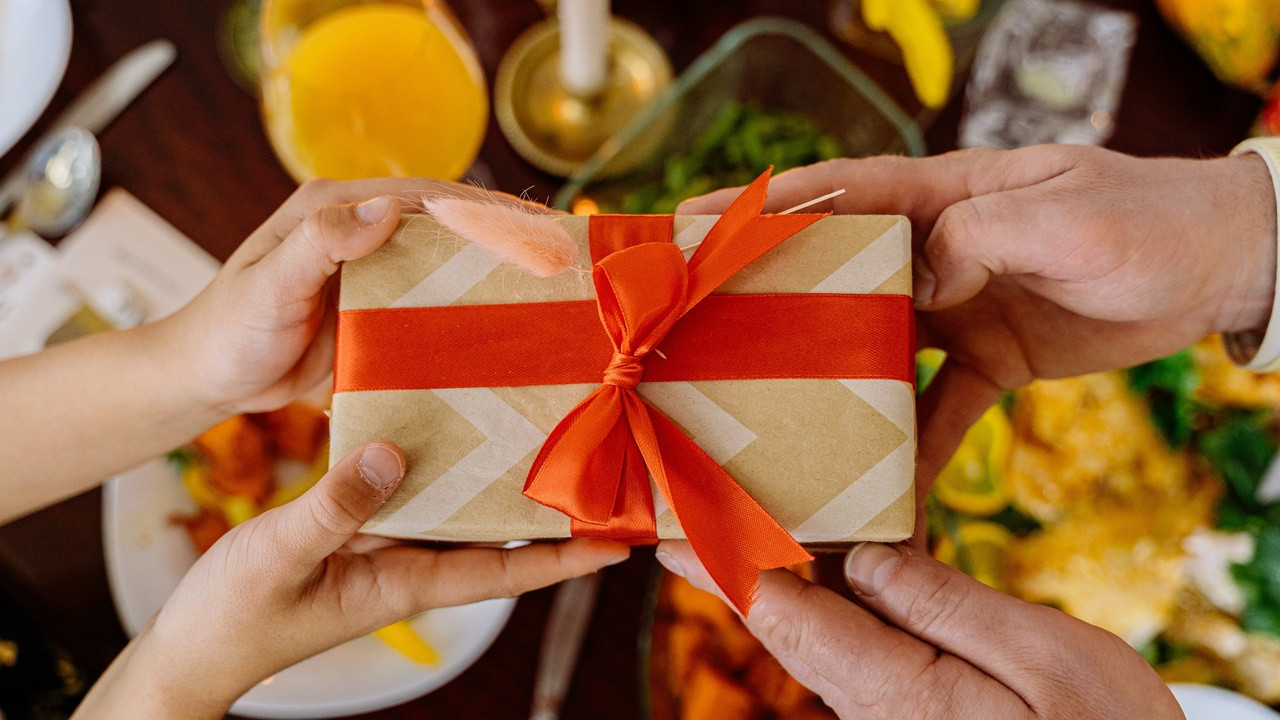It’s a familiar scene in many households: birthdays and holidays arrive, bringing with them an avalanche of new toys. While gifts are a wonderful expression of love, many parents are finding themselves overwhelmed by the sheer volume of stuff accumulating in their homes. If you’re seeking a more meaningful and less clutter-inducing approach to gifting for your children, Experience Gifts For Kids offer a fantastic alternative.
 Child receiving a gift, with focus on hands exchanging a wrapped present.
Child receiving a gift, with focus on hands exchanging a wrapped present.
This guide will explore how to gracefully request experience gifts for kids from well-meaning relatives and friends. We’ll delve into why experiences often hold greater value than material possessions, and how to navigate conversations with gift-givers to ensure your wishes are understood and respected. Plus, we’ll offer tips on introducing the concept of experience gifts to your children and making them just as exciting as unwrapping a box of toys.
Why Choose Experience Gifts for Children?
Before we discuss how to ask, let’s consider why experience gifts are such a beneficial option for children:
- Reduce Toy Clutter: Many modern homes are bursting at the seams with toys. Experience gifts directly address this issue by providing enriching activities rather than more possessions. This can lead to a calmer, more organized home environment, which benefits the whole family.
- Foster Lasting Memories: Toys can be quickly forgotten or discarded as trends change. Experiences, on the other hand, create lasting memories that children and families can cherish for years to come. Think of the joy of reminiscing about a special trip to the zoo or a fun-filled day at a water park.
- Boost Development and Learning: Experiences often offer invaluable opportunities for learning and growth. A trip to a museum can spark a child’s curiosity about history or science. A cooking class can teach practical skills and encourage creativity. Experience gifts can be tailored to a child’s interests and developmental stage, making them incredibly enriching.
- Strengthen Relationships: Many experience gifts are enjoyed together with family or friends, fostering stronger bonds and creating shared moments. These shared experiences are often more valuable than individual toys in building meaningful relationships.
- Encourage Appreciation for Non-Material Things: In a consumer-driven world, experience gifts teach children to appreciate things beyond material possessions. They learn to value time spent with loved ones, new skills acquired, and the joy of discovery.
How to Talk to Family About Experience Gifts
Requesting a shift from traditional gifts to experience gifts can feel a little daunting. Here’s how to approach the conversation with sensitivity and clarity:
 Image with text overlay "How to ask for experience gifts for kids"
Image with text overlay "How to ask for experience gifts for kids"
Opt for a Personal Conversation
Avoid sending a text or email when initiating this discussion. A phone call or, even better, an in-person conversation allows for a more nuanced and understanding exchange. Tone can be easily misinterpreted in written communication, so a direct conversation minimizes the risk of misunderstandings.
Frame it Positively, Not Negatively
Instead of focusing on what you don’t want (more toys), emphasize what you do want for your children: enriching experiences and lasting memories. Avoid language that sounds demanding or critical of past gift-giving. For example, instead of saying “No more toys!”, try “We’re really trying to focus on experiences this year.”
Explain Your “Why”
Share your reasons for preferring experience gifts. You might mention your desire to reduce clutter, your belief in the educational value of experiences, or your wish to create more family memories. Explaining your motivations helps gift-givers understand your perspective and feel more on board with your request.
Provide Specific Suggestions and Ideas
Don’t leave gift-givers in the dark about what experience gifts entail. Come prepared with a list of experience gift ideas for kids tailored to different interests and price points. This could include:
- Memberships: Zoo, aquarium, children’s museum, science center.
- Tickets: Sporting events, concerts, theater performances, movies.
- Classes: Art, music, dance, sports, cooking, coding.
- Activities: Trampoline park, indoor climbing, bowling, mini-golf, amusement park.
- Outdoor Adventures: Camping trip, hiking excursion, kayaking, bike rentals.
- Gift Certificates: For bookstores, art supply stores (to fuel creative experiences), or local activity centers.
- “Coupon” for an experience with the gift-giver: A special outing with Grandma, a baking day with Grandpa, a trip to the park with an aunt or uncle. These are often free or low-cost and highly meaningful.
Offering a range of options, including free or low-cost ideas, demonstrates that you are not seeking expensive gifts, but rather thoughtful and experience-based presents.
Be Gracious and Appreciative
Regardless of whether gift-givers fully embrace the idea of experience gifts, always express gratitude for their thoughtfulness and generosity. Remember that gift-giving is often an act of love and affection. Acknowledge their intention, even if the gift isn’t exactly what you were hoping for.
What if They Still Give Toys?
Despite your best efforts, some family members may still choose to give toys. Here’s how to handle this situation gracefully:
- Accept the Gift with Grace: Thank them sincerely for the gift. Avoid any negative comments or expressions of disappointment in front of the gift-giver.
- Remember You Have Choices: You are not obligated to keep every gift. If the toy is genuinely unwanted or adds to existing clutter, you can discreetly donate it later. Focus on teaching your children gratitude for the giver’s intention, rather than the gift itself.
- Reiterate Your Preference Gently in the Future: You can gently remind gift-givers of your preference for experience gifts in future conversations, but avoid being pushy or demanding. Consistency over time can gradually shift gifting habits.
Introducing Experience Gifts to Your Children
For children accustomed to receiving numerous toys, the transition to experience gifts might require some explanation and adjustment. Here’s how to make it exciting:
Pair an Experience with a Small, Tangible Item
To bridge the gap between material gifts and experiences, consider suggesting that gift-givers include a small, related item to unwrap along with the experience “coupon.” For example:
- Zoo membership: A small animal plush toy or a pair of binoculars.
- Movie tickets: Popcorn or movie candy.
- Art class: A set of art supplies or a sketchbook.
- Cooking class: A child-sized apron or a fun kitchen utensil.
This provides the excitement of unwrapping a present while still emphasizing the upcoming experience.
Build Anticipation and Excitement
Make the experience itself a big deal! Talk about it in advance, plan the details together, and create a sense of excitement leading up to the event. Take photos and videos during the experience to capture the memories and share them with the gift-giver. This reinforces the value of experiences and shows appreciation for the gift.
Share the Joy
After the experience, share your child’s enjoyment with the gift-giver. Send photos, videos, or a thank-you note describing how much fun your child had. This positive feedback reinforces the value of experience gifts and encourages them to continue giving them in the future.
Embrace the Gift of Experiences
Experience gifts for kids offer a wonderful way to shift the focus from material possessions to enriching activities and lasting memories. By communicating thoughtfully with family and friends and introducing the concept positively to your children, you can cultivate a culture of gifting that prioritizes joy, connection, and growth over clutter. Embrace the opportunity to unwrap joy, not just toys, and create cherished moments that will last a lifetime.

